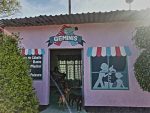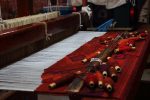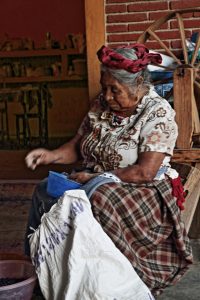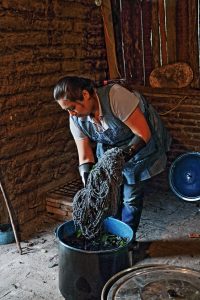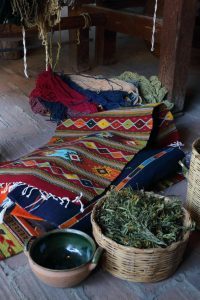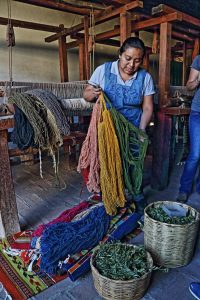“So then I thought, if I can shout about my own chickens, why not shout about other businesses? Now I make money from that too” Maria is an entrepreneurial lady with a micro-finance loan from En Via to set up her chicken business. But soon she was branching out into the ‘shout-out’ business. I was fascinated to meet her and other women entrepreneurs, to learn the stories behind their enterprises: rug weavers, caterers and an ‘emergency hairdresser‘. Learning about micro-finance in Mexico is one of the most worthwhile days I have spent in almost five years of full-time overland travelling.
A different day out Micro-finance in Mexico
Looking for something a bit different to do in Oaxaca, I saw an opportunity with Fundación En Via micro-finance tours. En Via lends small amounts of money to local businesses, but only to women. The micro-finance project loans are funded through responsible tourism tours, taking people to meet the ladies and to see how the businesses thrive in the local communities. Sounds interesting, huh? What I’m not going to do here, is explain the story of En Via and how they work – you can check them out on their website www.envia.org. What I will tell you, are fabulous success stories that I heard from the enterprising ladies and their businesses that we visited.
Some of the businesses have a tourism-focus, particularly weaving rugs, making souvenir crafts and so on. But many of the business are purely for local consumers, every-day enterprises that we might all be familiar with in our every-day lives.
The Caterer
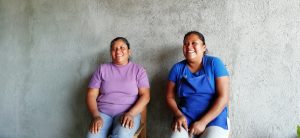 The first lady we met cooked us a delicious typical local lunch of chicken mole. With En Via’s micro-finance loan she bought equipment for her kitchen. She served us the lovely lunch in her home, but her kitchen is now set up for catering lunches which she delivers to workers in construction sites and other businesses around the area. Smart lady.
The first lady we met cooked us a delicious typical local lunch of chicken mole. With En Via’s micro-finance loan she bought equipment for her kitchen. She served us the lovely lunch in her home, but her kitchen is now set up for catering lunches which she delivers to workers in construction sites and other businesses around the area. Smart lady.
The Emergency Hairdresser
Then we met a young lady who had recently established a village hairdressing salon. Before teaming up with En Via, she had only a mirror and an old set of clunky hair clippers. With the micro-finance loan, she bought some paint to convert her father’s work-shed into a lovely little salon, fitted a work-top/shelf below the mirror, bought a chair and a new set of sharp electric hair-clippers. Now she’s in business as ‘Geminis’.
Geminis’ clients are mostly boys and young men, but she proudly explained that she is the village ‘Emergency Hairdresser’. Hmmm… curious… in whose world does a hair-do constitute an ‘emergency’? Well… here in rural Mexico the standards in schools for the length of boys’ hair is particularly strict. They will get sent home if it is just a couple of millimetres too long. On ‘test days’ this can be disastrous. They are refused entry to the exam hall and risk having to repeat their education and sit the test at a later date. It’s apparently not unusual for parents with little boys to be banging on the salon door at 07:30am, getting her out of bed to cut their child’s hair. With the ‘regulation hair cut’ the child can sit his school test and progress with the rest of the class to the next stage. That’s an ‘emergency hairdresser’ 😊
The Chicken Lady with a Voice
Our next stop was Maria, perhaps the most enterprising lady we met, who had started a chicken butchering business. She was already trading with a small corner store of dried/non-perishable goods but wanted to branch-out into fresh chickens. She applied for an En Via micro-finance loan to buy a decent knife and a chopping block. With these, she could buy live chickens from a farm some distance away, slaughter/gut them, then sell fresh chicken in her shop to villagers on a daily basis.
It all went well until a local farm started under-cutting her. This threatened her business, but being a super-sharp-cookie, she soon realised that this farm was preparing the chickens a bit late in the day. Villagers ideally wanted their daily chicken earlier, so that they had more time to cook it for lunch. Maria invested in a tannoy announcement system to fit to her home. Each morning, from a microphone in her living room, she booms out via speakers on her roof, a reminder to the whole the village that her chickens are all prepared, ready for purchase in the shop. Maria’s chickens are pot-ready, waaay before the farm-competitor has their chickens ready to sell and she has a string of loyal customers just waiting for her announcement each morning.
The announcer was a smart move, but Maria didn’t stop there. Her investment in the sound system had been so successful for her own business, that she offered the opportunity to other village businesses to announce their daily deals and special offers to the villagers… for a small fee, naturally. This became popular and one day, some neighbours asked if they could use her announcement system to wish their child Happy Birthday for all the village to hear. This too caught on, and soon every family in the village was paying Maria a small fee to give shout-outs on birthdays.
Finally, a pizza shop in a neighbouring village realised that Maria’s announcements could be heard across the countryside. As a business delivering pizzas to multiple villages, they saw an opportunity with Maria’s announcements. A shout-out from Maria’s house would reach out to two or three villages, all within an announcement radius of Maria. Ka-ching!!! Another source of income for Maria. Okay… yes… the ‘elephant in the room’ questions that we didn’t ask, have to be… Just how loud is that sound system? and what on earth do Maria’s immediate neighbours feel about the booming of adverts from her house?? Who knows, but it seems to be working well for Maria. All this from a tiny micro-finance loan that many of us wouldn’t miss from our monthly food bill.
Dye, Spin and Weave
The final village we visited is Teotitlán, known well to the local tourist industry as a centre of rug making. Many ladies there buy-in pre-dyed, pre-spun wool to weave into colourful rugs/small carpets to sell to tourists. But Soledad and her mother weren’t happy with buying-in the materials and the (often) synthetic dyes. They reckoned there’d be more profit if they spun and dyed the wool themselves. Not only that… if they could make their own natural dyes, Soledad could produce more beautiful natural hues. She would also have more control over the precise colours and textures of the wools used in the weaving.
With a micro-finance loan, Soledad and her mother invested in the materials to make their own dyes. They use natural substances like indigo, cochineal and pomegranate. With the dyes made by her mother, Soledad showed us the importance of precise timing (to the second!). Immersing yarn into buckets of dye will bring out different shades and depths of the same colour. There is both an art and a real science to the skill of these ladies. The rugs they ultimately produce are exquisite in both pattern (some traditional, but many her own designs), colour and weave quality.
It’s impressive that two generations of ladies are working together in this way. Soledad’s husband is also working in the business, but the icing on the cake is that more generations are getting involved. Soledad’s grandma helps with sorting the berries for dyes, and her young daughter is also showing an interest. They hope it will stay in the family long-term. Go ladies!!!
So if you haven’t already guessed… I can highly recommend a trip out with En Via from Oaxaca to learn about micro-finance in Mexico. Hundreds of women are benefitting from the programme. Not only will you learn in detail about how the micro-finance programme works, but you’ll get to interact with the ladies and ask questions (with an interpreter if you need it) about how it works for them. En Visa will put your US$50 fee to great use. There is no more responsible way to learn about (whilst at the same time, contributing to) the rural communities. Have a nice day 😊

